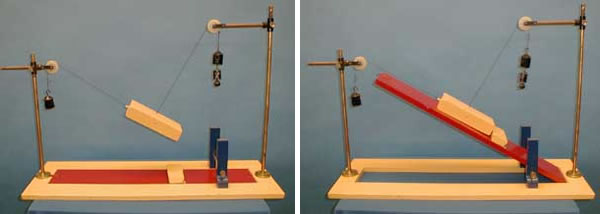Demos: 1J-06 Normal Force

This demonstration shows clearly that a surface actually "pushes" against an object in contact with it. This is done by showing that when such a force is removed, another has to take its place to maintain the equilibrium.
Directions: With the ramp locked in place at an angle of 30° to the horizontal, the wooden blocked is set on the ramp so that a chock holds it in place. Later, masses mper and mpar are attached as shown. The values of the two masses are such that when the ramp is lowered, the block remains in place, suspended in the air. (The apparatus will normally be set-up in this configuration.)
Suggestions for Presentation: With the block held in place with the chock, ask the students what forces hold the block in place. A well-drawn force diagram is essential here to establish the rationale for a force upward along the plane (parallel) and a force outward from the plane and perpendicular to it (per). Hanging the masses from the strings that pass over the pulleys creates tension forces in these same directions. Argue that these tension forces have now "canceled" the other forces so that if the plane is removed, the block will still experience the same forces as before and should remain in equilibrium. (It is quite effective to actually move the block away from equilibrium and then watch it return to its initial configuration.)
Note: The block’s mass is 0.4 kg. The forces required to hold the block in place must be:

Thus the masses required to create these tension forces are:
mpar = 0.20 kg
mper = 0.35 kg
Applications: This demonstration can set the stage for other demos or discussions in which a normal force is acting.
Last Updated: Nov 30, 2023 11:25 AM